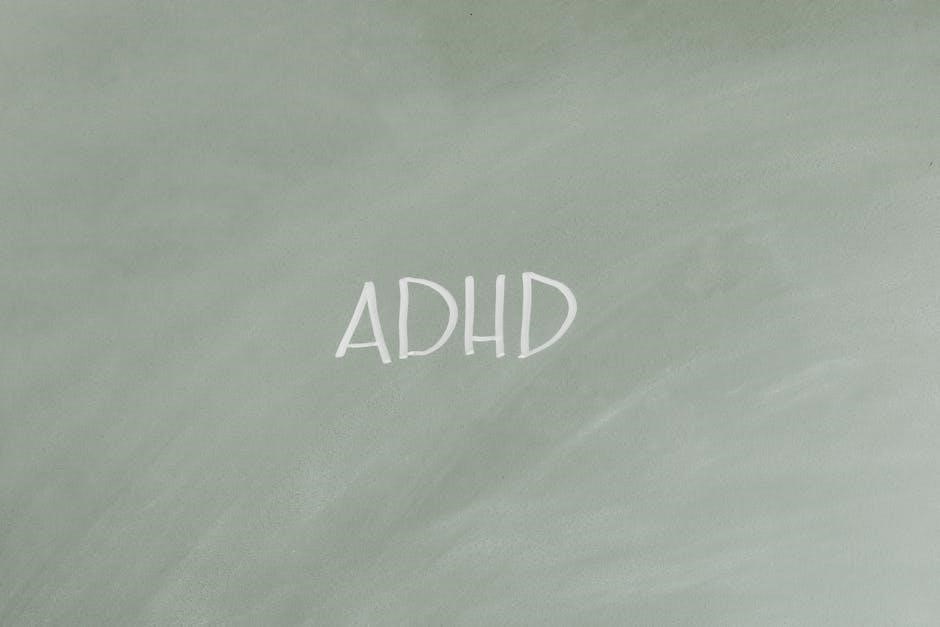The DIVA-5 ADHD Assessment is a semi-structured diagnostic tool designed for adults‚ focusing on core ADHD symptoms aligned with DSM-5 criteria to evaluate their impact on daily functioning accurately․
1․1 What is DIVA-5?
DIVA-5 is a semi-structured diagnostic interview designed to assess ADHD in adults‚ aligning with DSM-5 criteria․ It focuses on core symptoms like inattention‚ hyperactivity‚ and impulsivity‚ evaluating their presence in both childhood and adulthood․ The tool provides concrete examples to aid clinicians in determining chronic traits and their impact on daily life․ DIVA-5 is free‚ accessible worldwide‚ and requires interpretation by trained professionals‚ ensuring accurate diagnosis and differentiation from other conditions․ It is widely recognized for its structured approach to ADHD evaluation‚ making it a valuable resource globally․
1․2 Purpose of the DIVA-5 Assessment
The primary purpose of the DIVA-5 Assessment is to provide a comprehensive and structured evaluation of ADHD symptoms in adults․ It aims to facilitate accurate diagnosis by assessing the presence and persistence of core symptoms‚ such as inattention‚ hyperactivity‚ and impulsivity‚ from childhood to adulthood․ By focusing on DSM-5 criteria‚ DIVA-5 helps clinicians determine the chronic nature of symptoms and their impact on daily functioning․ This tool ensures a standardized approach to ADHD diagnosis‚ aiding in clinical decision-making and treatment planning while promoting accessibility and cost-effectiveness worldwide․

Development and Evolution of DIVA-5
DIVA-5 evolved from DIVA 2․0‚ a structured diagnostic tool for adult ADHD․ It aligns with DSM-5 criteria‚ ensuring a standardized approach for assessing ADHD symptoms in adults․
2․1 History of DIVA Assessments
DIVA-5 is the successor to DIVA 2․0‚ developed by experts like J․J․S․ Kooij and M․H․ Francken․ Initially based on DSM-IV-TR criteria‚ DIVA-5 now aligns with DSM-5 standards‚ providing a comprehensive diagnostic tool for adult ADHD․ Its evolution reflects advancements in understanding ADHD‚ ensuring accurate and reliable assessments․ The tool has been refined to focus on core symptoms‚ making it essential for clinicians worldwide in diagnosing and managing ADHD effectively․
2․2 Transition from DIVA 2․0 to DIVA-5
The transition from DIVA 2․0 to DIVA-5 marked a significant advancement in ADHD assessment․ DIVA-5 aligns with DSM-5 criteria‚ incorporating updated diagnostic standards and a broader scope of symptoms․ It retains the semi-structured interview format but now includes more detailed examples for both childhood and adulthood‚ enhancing clarity and accuracy․ This update ensures that clinicians can assess ADHD more effectively‚ addressing the complexities of adult ADHD diagnosis while maintaining the tool’s accessibility and reliability for global use․

How DIVA-5 is Used in ADHD Assessment
The DIVA-5 is a semi-structured diagnostic interview used by clinicians to assess ADHD in adults․ It evaluates symptoms from childhood and adulthood‚ focusing on core criteria to aid accurate diagnosis‚ and is available free of charge for global accessibility․
3․1 Structure of the DIVA-5 Interview
The DIVA-5 interview is a semi-structured diagnostic tool that evaluates ADHD symptoms in both childhood and adulthood․ It focuses on the 18 core symptoms outlined in the DSM-5‚ providing concrete examples to assess behavior․ The interview is divided into three main sections: childhood symptoms‚ persistence of symptoms into adulthood‚ and areas of impairment․ It also considers the chronic nature of symptoms and their impact on daily life․ The structured format ensures consistency and accuracy in diagnosis‚ making it a reliable tool for clinicians worldwide․
3․2 Role of Clinicians in the Assessment Process
Clinicians play a crucial role in the DIVA-5 assessment‚ as the tool requires professional interpretation․ They guide the structured interview‚ ensuring comprehensive evaluation of ADHD symptoms․ Clinicians assess the presence and persistence of symptoms‚ their impact on daily life‚ and determine if diagnostic criteria are met․ They also interpret responses‚ consider collateral information‚ and provide recommendations for further steps․ Their expertise ensures accurate diagnosis and appropriate treatment planning‚ making them essential to the assessment process․

Key Features of the DIVA-5 Assessment
DIVA-5 is a semi-structured interview aligned with DSM-5 criteria‚ focusing on core ADHD symptoms and providing examples for childhood and adulthood‚ requiring a trained clinician for interpretation․
4․1 Focus on Core ADHD Symptoms
DIVA-5 centers on evaluating core ADHD symptoms: inattention‚ hyperactivity‚ and impulsivity․ It provides clear examples to assess both childhood and adult behaviors‚ ensuring a comprehensive evaluation of symptom persistence and impact on daily life․
4․2 Alignment with DSM-5 Criteria
DIVA-5 is specifically designed to align with the DSM-5 criteria for ADHD‚ ensuring accurate diagnosis․ It evaluates 18 core symptoms across childhood and adulthood‚ focusing on chronicity and impact․ The tool mirrors DSM-5 requirements‚ assessing symptoms like inattention‚ hyperactivity‚ and impulsivity․ By adhering to DSM-5 guidelines‚ DIVA-5 ensures that diagnoses are reliable and consistent with international standards‚ making it a valuable resource for clinicians worldwide․
The Process of Conducting a DIVA-5 Assessment
The DIVA-5 assessment involves a structured interview lasting 1 to 1․5 hours‚ focusing on core ADHD symptoms in childhood and adulthood‚ ensuring alignment with diagnostic criteria․
5․1 Preparation and Setup
The DIVA-5 assessment requires careful preparation to ensure accuracy․ A trained clinician conducts the semi-structured interview‚ which typically lasts 1 to 1․5 hours․ The environment should be comfortable to facilitate open discussion․ Patients are informed about the process beforehand‚ including the focus on childhood and adult symptoms․ Collateral information from family or friends may be requested to provide a comprehensive understanding․ The clinician reviews the DSM-5 criteria and prepares examples to guide the conversation‚ ensuring a thorough evaluation of ADHD symptoms and their impact on daily life․
5․2 Duration and Complexity of the Assessment
The DIVA-5 assessment typically lasts 1 to 1․5 hours‚ requiring focused attention from both the clinician and the individual․ The structured format ensures a systematic evaluation of ADHD symptoms across childhood and adulthood․ The complexity lies in accurately assessing the chronic nature of symptoms and their impact on daily functioning․ Clinicians must skillfully probe for detailed examples‚ making the process both thorough and engaging․ The assessment’s depth ensures a reliable diagnosis‚ balancing efficiency with comprehensiveness to meet DSM-5 criteria effectively․

Interpretation of DIVA-5 Results
DIVA-5 results evaluate symptoms against DSM-5 criteria to determine ADHD diagnosis‚ assess severity‚ and measure impact on daily life‚ guiding tailored treatment recommendations․
6․1 Determining ADHD Diagnosis
The DIVA-5 assessment evaluates symptoms against DSM-5 criteria to determine ADHD diagnosis․ It examines the presence and persistence of 18 core symptoms across childhood and adulthood․ Clinicians assess whether symptoms meet diagnostic thresholds‚ considering their impact on daily functioning․ The interview provides concrete examples to clarify behavior patterns‚ ensuring accurate symptom identification; A diagnosis is made if symptoms persist‚ cause significant impairment‚ and align with DSM-5 requirements․ This structured approach ensures reliable and consistent diagnostic outcomes‚ guiding appropriate treatment plans․
6․2 Assessing Severity and Impact on Daily Life
The DIVA-5 assessment evaluates the severity of ADHD symptoms and their impact on daily life‚ including productivity‚ relationships‚ and emotional well-being․ Clinicians use the tool to understand how symptoms interfere with functioning across various domains․ The interview explores specific examples of impairment‚ such as difficulties in sustaining focus at work or managing daily responsibilities․ This comprehensive evaluation helps determine the extent to which ADHD affects an individual’s quality of life‚ guiding targeted interventions and support strategies․

Advantages and Benefits of Using DIVA-5
DIVA-5 offers improved diagnostic accuracy‚ is free of charge‚ and provides a structured‚ consistent approach to assessing ADHD in adults‚ ensuring reliable and accessible evaluations․
7․1 Improved Diagnostic Accuracy
The DIVA-5 enhances diagnostic accuracy by systematically evaluating ADHD symptoms in both childhood and adulthood‚ ensuring alignment with DSM-5 criteria․ Its structured format‚ which includes concrete examples of behavior‚ helps clinicians assess symptom persistence and impact on daily life․ By focusing solely on core ADHD symptoms‚ it minimizes the risk of misdiagnosis due to comorbid conditions․ The tool’s consistency and evidence-based approach make it a reliable instrument for clinicians worldwide‚ improving the precision of ADHD diagnoses and treatment plans․
7․2 Accessibility and Cost-Effectiveness
The DIVA-5 is widely accessible due to its free availability‚ reducing financial barriers for both clinicians and patients․ Its cost-effectiveness is enhanced by being downloadable without charge‚ making it a valuable resource globally․ The tool’s simplicity and structured design allow clinicians to administer it efficiently‚ reducing assessment time and costs․ This accessibility ensures that more individuals can benefit from accurate ADHD diagnoses‚ particularly in regions with limited resources‚ thereby promoting equitable mental health care․
Challenges and Limitations of DIVA-5
The DIVA-5 requires trained clinicians for accurate interpretation‚ limiting its accessibility without professional expertise․ Self-reporting errors and the need for detailed childhood recollection can introduce diagnostic challenges․
8․1 Need for Trained Clinicians
The DIVA-5 assessment requires skilled clinicians to administer and interpret effectively‚ ensuring accurate ADHD diagnoses․ Proper training is essential to navigate complex symptom evaluations and contextualize patient responses within DSM-5 criteria․
8․2 Potential for Self-Reporting Errors
The DIVA-5 relies on accurate self-reporting‚ which can be problematic as patients may underreport or overreport symptoms due to limited self-awareness or recall bias․ Without professional guidance‚ misunderstandings of questions or misjudgment of symptom severity can occur‚ potentially leading to inaccurate diagnoses․ This underscores the importance of clinician-administered assessments to ensure reliable and valid results‚ as self-reported data alone may not capture the full complexity of ADHD symptoms and their impact on daily life․

DIVA-5 and Comorbidity with Other Conditions
Comorbidity is common in ADHD cases‚ with 75% of adults experiencing additional conditions․ The DIVA-5 focuses solely on ADHD symptoms‚ necessitating comprehensive assessments to address co-occurring disorders․
9․1 Prevalence of Comorbid Disorders
Comorbid disorders are highly prevalent in individuals with ADHD‚ affecting approximately 75% of cases․ Common co-occurring conditions include mood disorders‚ anxiety‚ and substance use issues․ The DIVA-5 focuses solely on ADHD symptoms‚ emphasizing the need for comprehensive psychiatric evaluations to identify and address these comorbidities effectively․
9․2 Importance of Comprehensive Assessment
A comprehensive assessment is crucial for accurately diagnosing ADHD and identifying co-occurring conditions․ The DIVA-5 interview provides a detailed evaluation of ADHD symptoms but should be complemented with a broader psychiatric assessment to detect comorbidities․ This holistic approach ensures proper diagnosis and treatment planning‚ addressing both ADHD and related conditions effectively․ It highlights the need for clinicians to consider the full spectrum of mental health issues when evaluating individuals with ADHD symptoms․

Global Adoption and Recognition of DIVA-5
DIVA-5 is widely recognized globally for its evidence-based approach and alignment with DSM-5 criteria‚ making it a valuable tool for ADHD diagnosis in diverse countries and cultures․
10․1 Use of DIVA-5 in Different Countries
DIVA-5 is increasingly adopted worldwide‚ particularly in Europe and Ukraine‚ for its structured approach in diagnosing adult ADHD․ Its accessibility and alignment with international criteria make it a preferred tool across diverse healthcare systems‚ ensuring consistent and reliable assessments․ The tool’s adaptation into multiple languages further enhances its global utility‚ facilitating its use in various cultural and clinical settings to address ADHD diagnosis effectively․
10․2 Cultural Adaptations and Translations
DIVA-5 is available in multiple languages‚ ensuring its accessibility across diverse cultures․ Its translations maintain the integrity of DSM-5 criteria while adapting to cultural nuances‚ making it suitable for global use․ The tool’s structured format remains consistent‚ enabling accurate ADHD assessments worldwide․ This adaptation ensures that individuals from varied linguistic and cultural backgrounds can benefit from a reliable diagnostic process‚ fostering equitable access to ADHD evaluation and care․

Special Considerations for Specific Populations
DIVA-5 accommodates unique needs‚ such as ADHD in women and individuals with intellectual disabilities‚ ensuring tailored assessments that account for diverse symptom presentations and diagnostic challenges․
11․1 Assessing ADHD in Women
ADHD in women often presents differently‚ with symptoms like inattention and emotional dysregulation being more common․ The DIVA-5 assesses these manifestations‚ considering societal and hormonal factors․ Its structured approach helps identify symptoms that may be masked by coping mechanisms or misattributed to other conditions․ By focusing on childhood and adult experiences‚ the DIVA-5 ensures accurate diagnoses‚ addressing the unique challenges women face in recognizing and reporting ADHD symptoms․ This leads to more personalized and effective treatment plans․
11․2 Using DIVA-5 for Individuals with Intellectual Disabilities
The DIVA-5 is adapted for assessing ADHD in individuals with intellectual disabilities‚ ensuring accurate diagnosis despite cognitive challenges․ The tool uses simplified language and concrete examples to evaluate core symptoms․ It considers developmental factors and functional impact‚ aiding in distinguishing ADHD from other conditions․ Clinicians require specialized training to administer the DIVA-5 effectively in this population‚ ensuring reliable results․ This adaptation supports tailored interventions‚ improving outcomes for individuals with co-occurring intellectual disabilities and ADHD․
Case Studies and Real-World Applications
The DIVA-5 has proven effective in real-world clinical settings‚ aiding clinicians in diagnosing ADHD accurately and guiding targeted interventions‚ as demonstrated through numerous case studies globally․
12․1 Examples of Successful Diagnoses
Case studies highlight the DIVA-5’s effectiveness in accurately diagnosing ADHD․ For instance‚ a 35-year-old patient with persistent inattention and impulsivity was assessed using the DIVA-5‚ revealing a clear pattern of symptoms meeting DSM-5 criteria․ The structured interview provided detailed insights into childhood behaviors and current impairments‚ enabling a precise diagnosis and personalized treatment plan․ Such examples demonstrate how the DIVA-5 bridges clinical practice and research‚ ensuring reliable ADHD assessments that improve patient outcomes significantly․
12․2 Lessons Learned from Clinical Practice
Clinical experience with the DIVA-5 highlights the importance of thorough preparation and trained clinicians to ensure accurate diagnoses․ Properly interpreting the structured interview requires a deep understanding of ADHD symptoms and their impact on daily functioning․ Additionally‚ incorporating collateral information from family or friends enhances diagnostic accuracy․ Clinicians have learned to balance the semi-structured format‚ allowing flexibility while maintaining focus on core symptoms․ These insights underscore the tool’s value in real-world applications‚ emphasizing the need for ongoing training to maximize its effectiveness in diverse clinical settings and patient populations․

Future Directions for DIVA-5 Development
Future updates may include integration with emerging technologies‚ expanded cultural adaptations‚ and enhanced accessibility to improve diagnostic accuracy and global reach for ADHD assessments․
13․1 Potential Updates and Improvements
Future updates to DIVA-5 may include integrating advanced technologies‚ such as AI-driven analysis‚ to enhance diagnostic accuracy․ Expanding cultural adaptations and translations will improve accessibility worldwide․ Additionally‚ incorporating feedback from clinicians and patients could refine the assessment process‚ ensuring it remains aligned with evolving ADHD research; Potential improvements may also involve streamlining the interview structure and developing digital platforms for easier administration․ These updates aim to maintain DIVA-5 as a gold standard for ADHD diagnosis‚ ensuring it meets the needs of diverse populations and stays current with scientific advancements․
13․2 Integration with Emerging Technologies
DIVA-5’s future may involve integrating emerging technologies like artificial intelligence and machine learning to enhance diagnostic precision․ Digital platforms could enable remote assessments‚ increasing accessibility for diverse populations․ Additionally‚ incorporating virtual reality might provide immersive simulations to better assess ADHD symptoms in real-world scenarios․ These technological advancements aim to streamline the evaluation process‚ improve accuracy‚ and expand the reach of the DIVA-5 tool globally‚ ensuring it remains a cutting-edge resource for ADHD diagnosis and management․
Resources and Support for DIVA-5 Users
The DIVA-5 offers training materials‚ guidelines‚ and community networks to support users‚ ensuring clinicians can effectively master and utilize the assessment tool for accurate ADHD diagnoses․
14․1 Training Materials and Guidelines
The DIVA-5 provides comprehensive training materials and guidelines to ensure clinicians master the assessment tool․ These resources include detailed manuals‚ workshops‚ and webinars․ The DIVA Foundation offers free downloadable materials‚ such as the DIVA-5 ADHD PDF‚ to guide clinicians through the diagnostic process․ These tools emphasize accurate symptom evaluation and alignment with DSM-5 criteria․ Additionally‚ the foundation’s website hosts a wealth of information‚ including instructional videos and case studies․ Regular updates ensure clinicians stay informed about best practices‚ fostering consistent and reliable ADHD assessments worldwide․
14․2 Community and Professional Networks
The DIVA-5 ADHD assessment is supported by a global community of professionals and clinicians․ These networks facilitate collaboration‚ knowledge sharing‚ and best practices in ADHD diagnosis․ Through forums‚ webinars‚ and workshops‚ clinicians can connect with experts and peers․ The DIVA Foundation encourages open dialogue to enhance diagnostic accuracy and stay updated on the latest advancements․ This collective effort fosters a supportive environment for professionals to improve patient outcomes and advance ADHD care worldwide․
The DIVA-5 ADHD assessment is a vital tool for accurately diagnosing ADHD in adults‚ offering a structured approach aligned with DSM-5 criteria and fostering global recognition․
15․1 Summary of Key Points
The DIVA-5 is a structured diagnostic tool for ADHD in adults‚ aligned with DSM-5 criteria․ It assesses core symptoms in childhood and adulthood‚ ensuring accurate diagnoses․ The tool requires trained clinicians for interpretation and is freely available‚ making it accessible worldwide․ DIVA-5 focuses solely on ADHD symptoms‚ emphasizing their impact on daily life․ Its global recognition and cultural adaptability highlight its effectiveness in standardizing ADHD assessments․ This tool plays a crucial role in improving diagnostic accuracy and understanding ADHD’s complexities across diverse populations․
15․2 Final Thoughts on the Importance of DIVA-5
DIVA-5 is a pivotal tool in standardizing ADHD diagnoses‚ ensuring accuracy and consistency globally․ Its structured approach bridges gaps in adult ADHD care‚ offering a reliable method for clinicians․ By focusing on core symptoms and their impact‚ DIVA-5 aids in reducing misdiagnoses and underdiagnoses‚ enabling effective treatment plans․ Its accessibility and cultural adaptability make it indispensable for diverse populations․ Ultimately‚ DIVA-5 empowers clinicians and patients alike‚ fostering better understanding and management of ADHD‚ thereby improving quality of life for those affected․
